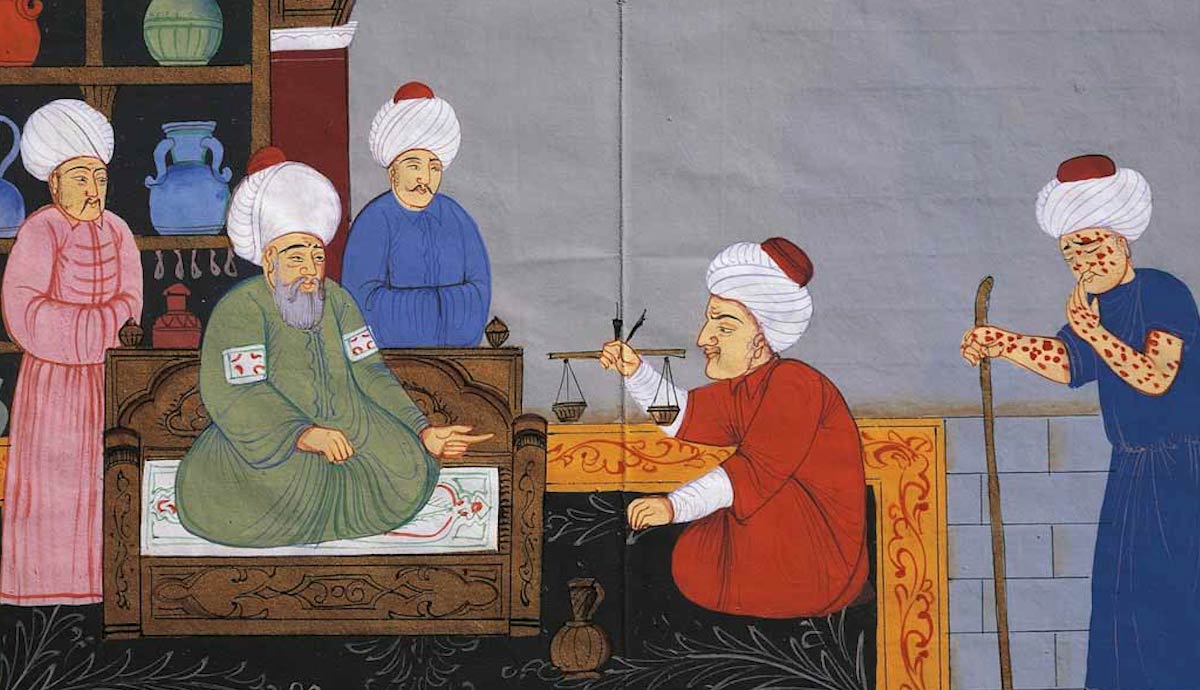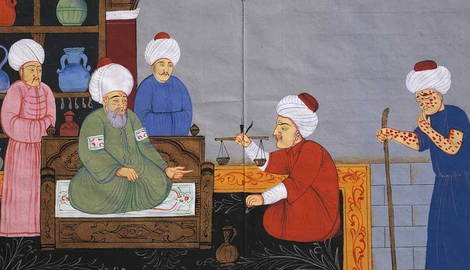
Paracelsus is one of the most consequential figures in the history of science due to his innovation in iatrochemistry, which consisted of combining alchemy and medicine. This resulted in a new theory of medicine, based on drug treatments of diseases. Paracelsus’ alchemical medicine reached many places, even the Ottoman Empire. Read on to learn more about the elements of Paracelsus’ approach to treatment that caught the attention of Ottoman medics.
Medicine in the Ottoman Empire and Paracelsus

Medicine in the Ottoman Empire was cosmopolitan. In the early modern period, the medical culture was rather uniform all around Europe and the Middle East. Be it in Paris or Istanbul, all physicians operated under the umbrella doctrine of Galenism.
More so, medicine was an accessible discipline in the Ottoman Empire, as non-Muslim diasporas had access to Ottoman education and guilds. The large numbers of Sephardic Jewish and Greek physicians and the Italian, English, or French ones that accompanied traders were likely the reason why Paracelsus’ medicine reached the Ottomans in the first place. The adoption of Paracelsian medicine in Istanbul was by no means sudden or radical. The influence of Avicenna—or Ibn Sina—the Galen of the Islamic world, was diminished in favor of a more empirical practice of medicine. When Paracelsus’ new medicine started to find adepts in the capital of the Ottoman Empire, its assimilation was, however, partial.
What Came Before Alchemical Medicine?

Ottoman physicians started to get interested in the new medicine (or tibb-i cedid in Ottoman Turkish) in the 1650s. Considering that the capital was in Istanbul, the diffusion of knowledge started there. The medical establishment was split into two camps: the hospital physicians and the professors of medicine in the medrese (an Islamic institution of learning) and the marketplace healers who specialized in drug prescriptions.
If Paracelsus was proposing a new medicine, what did the old medicine look like? Its main theorists were Galen (129-216 AD) and Avicenna (980-1037). Galen was a Greek-Roman physician and philosopher, and Avicenna was a Persian polymath in all things science. Their influence lasted up to the 1800s.
In spite of the centuries between them, both professed the same theory of medicine featuring the four humors doctrine. Going back to Hippocrates, the humoral theory advanced that the human body functioned on the basis of black bile, yellow bile, blood, and phlegm. The ideal state of complete health required all four humors to be in balance. All conditions and diseases stemmed from an imbalance that happened in one of the four essential fluids. To each, Galen also attached a temperament. For blood, there was the sanguine temperament, black bile went with melancholic, yellow bile with choleric, and naturally, with phlegm came phlegmatic.
Putting the humors in balance meant that medicine was based on regimens and diets, being more preventive than interventionist. A famous practice was that of blood-letting, which was thought to cure numerous afflictions, down to the daily headaches. This practice was probably the most enduring Galenic form of treatment, which also lasted up to the late nineteenth century.
Who Was Paracelsus and What Made Him Famous?

Philippus Aureolus Theophrastus Bombastus von Hohenheim (1493-1541), better known by the cognomen of Paracelsus, was most certainly one of the most consequential and controversial figures in the history of science, medicine, and alchemy. Paracelsus believed that observation, witchcraft, and travels educated a physician much more effectively than Hippocrates, Galen, or Avicenna. His revolt towards the canonical authors came from the fact that they were outdated since hundreds of years of new diseases and their potential ailments held no place within their pages. Since Galen didn’t know about syphilis, physicians had to move towards a new theory concerning the human body.
In fact, Paracelsus’ refutation of Galenic medicine was fundamental, denying the viability of the humoral theory itself. His theory of medicine and the origin of disease owed a lot to his alchemical formation, which opened the way to tackling minerals and their potential pharmacological application. The term spagyric, which was first formulated in his Basel lectures, accounts for the methods instrumented by alchemists in the process of transmuting organic and inorganic matter altogether, through different operations like heating or distillation. His spagyric art was the main catalyst of his fame. Paracelsus transformed medicine thanks to his implementation of alchemical procedures within the treatment practices, harboring a new way of understanding the pharmaceutical properties of already familiar substances. The combination of alchemy and medicine that Paracelsus came up with was iatrochemistry.
Therefore, instead of decoctions or other herbal mixtures (also known as Galenicals), Paracelsus suggested that for each disease possessing an underlying arcanum, there should be a corresponding arcanum cure. Arcanum can be roughly translated as secret. Next to Paracelsus, others were also cementing the medical breakthrough that he started. In 1543, the Italian Andrea Vesalius (1514-1564) published his lavish treatise on anatomy On the Fabric of the Human Body, and William Harvey (1578-1657) described blood circulation.
The New Medicine and the Ottomans

The combination of alchemy and medicine that Paracelsus came up with was iatrochemistry. This new approach, which sought to translate medicine and physiology in terms of chemistry, slowly became acceptable. By the time its fame reached Istanbul, Paracelsus’ medical chemistry was already incorporated into academic medicine.
In fact, Paracelsus’ followers achieved an important feat by re-conciliating Galenic medicine with innovative iatrochemistry. It is through the works of Paracelsists that Ottomans come to grips with the new medicine. Oswaldus Crollius (c. 1560-1608) and Daniel Sennert (1572-1637) were the actual vehicles of the propagation of iatrochemistry in Istanbul.
This was also no accident since Ottoman medicine had always been syncretic. While following the Greco-Persian tradition, Ottomans lent an ear to other cultures as well. The practice of chemical recipes was not unheard of, since Jewish physicians in Ottoman cities involved in practical kabbala promoted the use of wine and spirits in medicine.

The first advocate of the new medicine, Sali ibn Nasr ibn Sallūm, a physician born and trained in Aleppo, Syria, wrote a treatise that described new diseases and cures that Crollius and Sennert described in their own writings. His Culmination of Perfection in the Treatment of the Human Body preaches drug therapy and treatments based on mineral acids, inorganic salts, and alchemical procedures as answers to the healthcare crisis Ottomans were dealing with.
Ibn Sallūm became the chief physician of Sultan Mehmed IV following the success of his book on epidemics, in which he explained the plague through both heavenly and earthly causes. At that point in time, in light of the growing population and territories of the Empire and the ceaseless trade and travels of both foreigners and Ottomans, public health degraded with no solution in sight.
Ottomans were therefore inclined toward practical medicine that promised fast results. They were not interested in the causes of a headache, but rather in treating it as fast as possible. Iatrochemistry’s drug-based approach to treatment seemed to be a solid answer. Chemical medicine spread fast and wide, and it was not thanks to Ibn Sallum’s treatise. It was actually quickly adopted by marketplace doctors, which in light of the precarious condition of hospitals and the official physician’s decrepit social and economic position, became an alternative platform that offered quick treatment for both rich and poor.
Tibb-i Cedid and Treatment on the Field

The new medicine, or, as Ottomans called it, tibb-i cedid, relied heavily on salt, sulfur, and mercury and the numerous alchemical procedures which combined organic and inorganic ingredients into the final treatments. Its adepts had to learn not only about recipes and proportions but also about fermentation, calcination, distillation, maceration, and much more. In fact, due to endless requirements from whoever tried preparing Paracelsian cures, early tibb-i cedid met with little success in the first decades. Given that this knowledge traveled continents and suffered multiple translations and corruptions, it was a recipe set for disaster.
The concept of dosage and of lethal overdose proved to be a hard test for Ottoman physicians and apothecaries. The variety of scales was in itself a quintessential factor. More so, given the vastness of the Ottoman Empire, weight units differed in each region. Therefore, no matter the intentions of whoever prescribed a drug, attaining a calibrated cure was close to impossible.
Its promises and accessibility started to attract questionable individuals who sold themselves as apothecaries. Such attempts to earn a quick dime were bolstered by the appeal of the new and the innovation. As these swindlers grew in number, tibb-i cedid started to acquire a bad reputation. As the phenomenon of market medicine grew, the sultans became aware of the dangers.
Paracelsus and Alchemical Medicine in the Ottoman Empire

Starting in 1703, several edicts were issued in Edirne in an effort to regulate the practice of medicine and medical treatment. Hence, physicians who were proven to have hurt their patients were banished. Moreover, the European doctors who practiced the new medicine were expelled from the Ottoman Empire.
However, the arrival of new practices and approaches to illness and epidemics changed the way the Ottomans viewed the profession. At the point when Paracelsian ideas reached the Ottoman Empire, the scholastic, learned medical establishment of the medrese still possessed authority. During the seventeenth century, this hierarchical scheme that gave scholastics a higher ground over the medical marketplace started to diminish. By 1729, an edict declared that physicians had to follow the canons of medicine and use the knowledge they had gained through experience to prescribe remedies to patients.
We can therefore say that the adoption of chemical medicine created a parallel medical system of treatment outside of hospitals and universities. Despite its early inefficiency and countless victims, Paracelsian iatrochemistry championed a different avenue of treatment. The treatment of symptoms rather than causes that the Ottomans were interested in finding is to this day the main medical philosophy.








